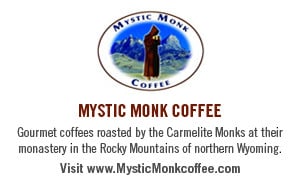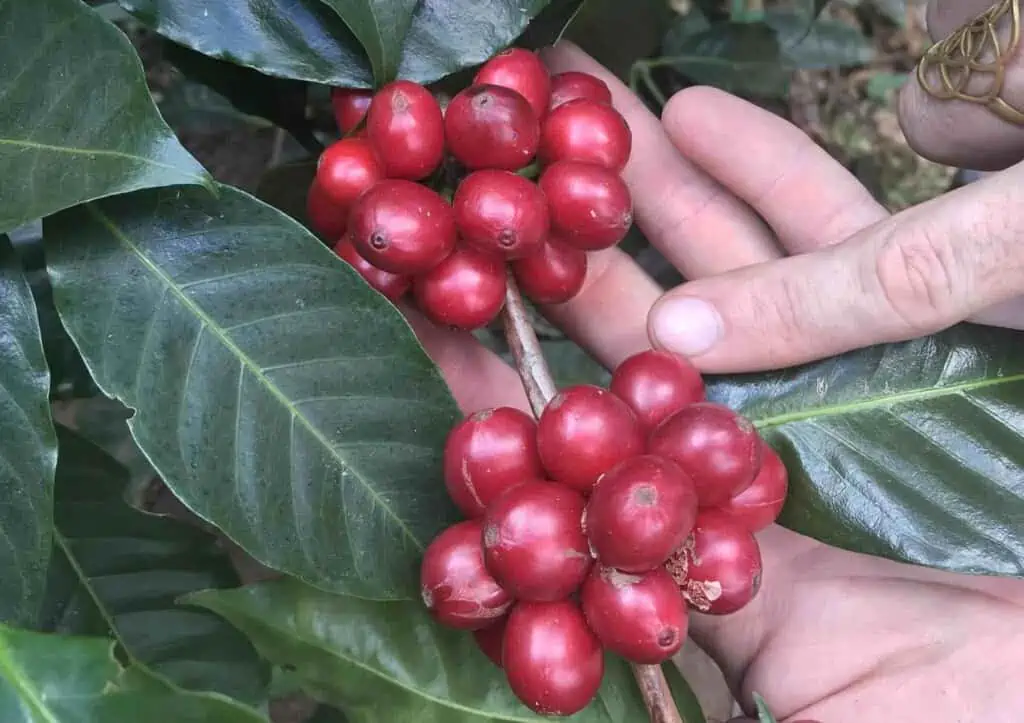
Red Bourbon cherries growing on Gloria Rodriguez’s Finca Nejapa in the Apaneca-Ilamatepec growing region, El Salvador. Courtesy of Chromatic Coffee.
For many North Americans, the classic coffees of Central America constitute the essential experience of fine coffee. Until relatively recently, wet-processed or washed coffees from traditional tree varieties produced by a string of Central American countries — Guatemala, Nicaragua, El Salvador, Costa Rica, Honduras, Panama – typically appeared near the top of specialty coffee menus. But that classic Central America cup has been under duress for decades, pressured by macro factors like coffee economics and climate change, as well as by changing trends in specialty coffee itself.
How is that classic Central America cup faring today? Will a coffee lover who has retained (or recently developed) a taste for the often bright, usually balanced, quietly nuanced Central America cup find satisfying examples on contemporary specialty roasters’ websites and café menus?
To try to answer that question we asked the specialty coffee community to send us their best classic Central America coffees. In this case, we defined classic by tree variety and processing method. We asked for coffees produced from traditional varieties of coffee long grown in Central America, and processed by the traditional washed method (fruit skins and flesh are removed from the beans immediately after picking and before drying), until recently the almost universal method of preparing fine coffee for export in Central America.
A Bitter Backstory
For an overview of what we tasted and the issues behind what we tasted, read on. But first the backstory of the classic Central America cup, a story filled with challenge and difficulty. The economic challenge probably started in 1989, when the United States and Brazil colluded to dissolve the International Coffee Agreement. That agreement stabilized coffee prices by assigning production quotas to most of the world’s coffee growing countries, including those in Central America. When the Agreement ended, perennial oversupplies of coffee triggered the devastating price fluctuations that have dominated the global coffee market ever since. Many Central American producers have simply given up on coffee, battered by relentlessly low prices only occasionally relieved by temporary price spikes.
Recall that the coffee plant is not native to Mesoamerica. It was brought by colonizers and was bred from such a tiny number of parent trees that Arabica coffee is now considered among the least genetically diverse crops on the planet. This genetic uniformity leaves it highly susceptible to disease and climate change. Nature is unkind to even our best-laid plans, so it’s no surprise that the clock eventually ran out on monocultured Arabica coffee trees in the form of a particularly destructive fungus.
Sweeping across Central America by 2012, an especially virulent strain of the coffee leaf rust disease left farmers in dire straits. Guatemala, Costa Rica and Honduras declared states of phytosanitary emergency. The losses in coffee harvest from Central America in the 2012–2013 season were estimated to be close to 2.7 million 60 kg bags, around $500 million in unrealized revenue. Ten years later, rust remains a daily reality in every corner of Central America.
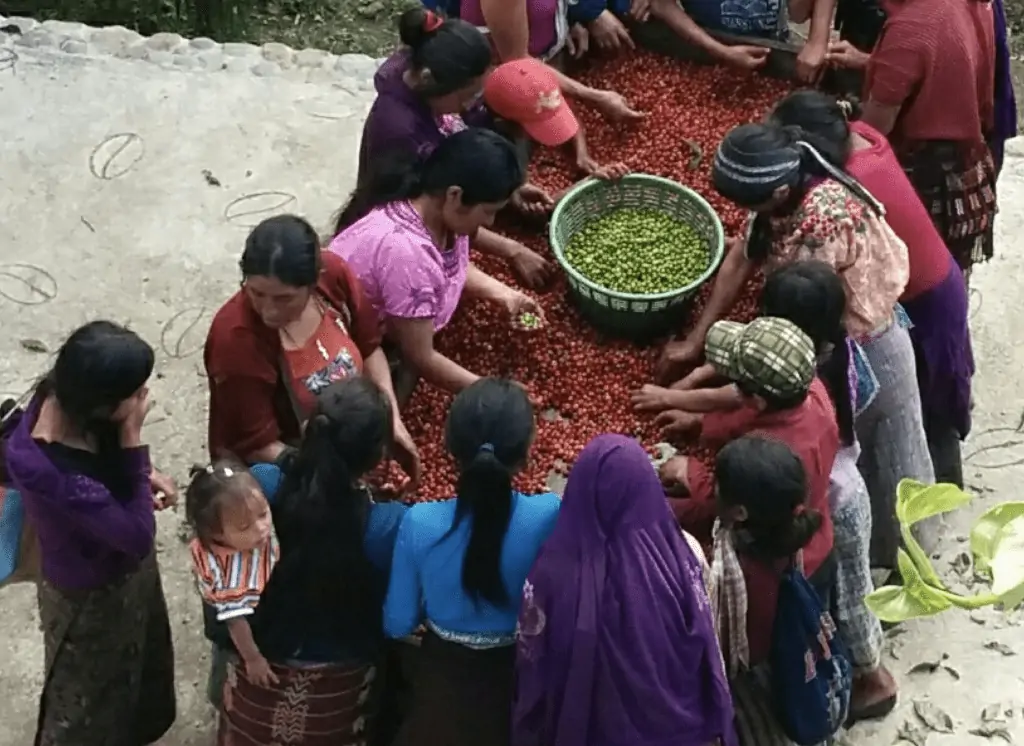
Sorting coffee cherries at El Injerto Farm in Huehuetenango, Guatemala. Courtesy of Equator Coffees.
Nevertheless, coffee survives throughout the isthmus, though it continues to struggle under escalating pressures of climate change, disease, the legacy of colonialism, extractivist capitalism, ill-advised political meddling, the forces of micro- and macro-economics, and the growing attrition of younger farmers and farm workers. Overall, coffee production and value adjusted for inflation have fallen consistently in Central America, year after year, for at least the last decade.
Specialty Coffee to the Rescue
Nevertheless, the new specialty coffee movement that developed in North America in the latter decades of the 20th century did its best to differentiate and elevate the classic Central America cup in both prestige and value.
In the world’s commodity exchange marketplace, futures contracts for Arabica coffee are underpinned by a category of coffee beans known blandly as “washed milds.” These are coffees produced by 20 deliverable origins, including every country in Central America except Belize. It became immediately apparent to early specialty coffee pioneers that it was unfairly reductive to simply pile coffees from these diverse — if geographically proximate — origins into a single category like “high-grown milds.” Roasters scrambled to assemble their lineups of Central American beans by country and sometimes by region. These coffees, alongside other staples from Colombia, Ethiopia, Sumatra and Kenya, formed the centerpiece of nearly every specialty roaster’s menu by the turn of the last century.
There were some common threads in the ways specialty roasters spoke of coffees from Mesoamerica, but they were usually overshadowed by assumed differences. Guatemalan coffees were often characterized as deep, lush and lightly fruity. Nicaraguas were caramelly, nutty, and a hint citric, while Honduran entries were said to be similar but with greater depth and more chocolate flavor. The coffees of El Salvador were often characterized by their milk-chocolaty velvetiness and dried fruit flavors, while Costa Ricas always seemed to bring ripe red fruit like cherries and apples to the table. And Panama, reliably decadent, was often described in terms of dark chocolate tones and elegant floral notes. While these overly generic descriptions might still ring vaguely true, the average trend in much of the region over the past decades has been one of homogenization. It would be difficult for even the most seasoned professional to distinguish between a bulked regional blend from Honduras versus one from El Salvador.
The Reimagining of the Central America Cup
Despite the added value of specialty differentiation by region and origin, prices paid to producers for classic Central America washed coffees, even for some of the best and most admired, have remained low, often unsustainably so. Consequently, over the past decade the leading edge of the specialty coffee world, starting with the growers, but including importers, roasters, and consumer enthusiasts, has conspired to defeat the relentless devaluing of the classic Central America cup by changing that cup into something different, often radically different. Farmers have adopted new tree varieties and flashy, sometimes extravagant experiments with processing. The startlingly different-tasting Geisha (also spelled Gesha) variety was first recognized as something special in Panama, and coffees processed by now-trendy anaerobic fermentation methods saw their first debut on the world stage from Central American farmers. Every specialty coffee roaster in the world now seems to be clamoring for something different, unique, uncommon, and untraditional from Central America.
Regular readers of Coffee Review are doubtless aware of this trend, as our review pages are crowded with coffees striving for the different and unusual, often coffees produced from the Geisha variety and/or coffees with startling new cup profiles achieved through processing experimentation.
Celebrating Traditional Excellence
However, the simple truth is that excellent traditionally cultivated and processed coffees from Central America are still being produced, despite the odds stacked against them. The more than 80 classically produced Central America coffees we tested this month averaged an impressive rating of 88, nudging up toward 89, and the 10 we chose to review averaged 92 with a high of 94.
Plenty of screen time today is given to the uncommon, the unconventional, the unexpected. Without innovation, the coffee world would surely stagnate. Yet isn’t it remarkable when a few coffees using traditional means rise above the commodity sea of generic mass-produced mediocrity to stun us with their quiet elegance? We’ve chosen, for this report, to celebrate these quiet successes, to recognize the achievement of a distinction achieved through traditional practices meticulously pursued, from cultivation of familiar tree varieties through careful harvesting to attentive use of conventional washed processing techniques.
Characterizing the Classic
We could divide the 10 coffees reviewed here into a couple of very roughly defined sensory categories: those that express the genius of the Central American cup in its brighter, citrusy and floral pleasures and those that are more resonantly structured around a layering of savory depth and complexly expressed sweetness. Perhaps we could add a third category for those that lead with chocolate and nut. But all express a certain overall balance, and none add notes we don’t generally associate with coffee — no brandy-like alcohol whiffs from natural-processed beans, for example, or sweet tang and odd aromatic notes from anaerobic fermentation. And with regard to tree variety, none manage the sometimes over-the-top floral perfumes and general aromatic extravagance associated with the Geisha variety.
But there is considerable range and difference among the pleasures offered by these coffees. Reasons for these differences are difficult to even hypothesize, much less determine. Although, as always, we can take a look at both processing method and tree variety for hints.
Processing and the Classic Cup
The samples we solicited were all processed using a water-intensive technique in the “washed” coffee tradition. The coffee fruit is delivered to a centrally located wet mill as soon as possible after harvesting. Skins and pulp are removed, and the beans are fermented in open tanks using indigenous yeasts and bacteria to soften and loosen the remaining sticky fruit pulp. The beans are then washed, scrubbed, graded, and dried in the sun. All of these acts require considerable labor and care. And the details of these practices vary greatly among regions, farms and mills.
Although variations in the details of washed processing impact the final cup, sometimes dramatically, they are seldom documented. The final cup (as is always the case in specialty coffee) is where the proof lies. Buyers — exporters, roasters, then consumers — make decisions ultimately based on what they taste. Their decisions may also be conditioned by other important considerations like loyalty to growers, certifications, environmental practices, socioeconomic practices, etc.
All of that is why we write reviews in addition to assigning numerical ratings. We tell you a little about those who produced the coffee, but considerably more about how the coffee tastes to us in the cup. The numerical rating is just a starting point. The 10 coffees we review here all offer pleasing versions of the classic Central America cup, but the nuances of the pleasures differ and can’t be reduced to a simple number.
Tree Variety and the Classic Cup
Throughout Central America, the original source of tree genetics was two related but distinct cultivated varieties known as Typica and Bourbon, each of which was filtered through European colonization but ultimately trace their original sources back to trees selected from Yemen in the 17th century. These cultivars, sometimes suggested as “legacy” or “heirloom” varieties, populated the growing regions of Central America almost exclusively until the mid-20th century. Two of this month’s top-rated coffees were produced exclusively from trees of these original cultivars. Chromatic Coffee’s El Salvador La Lagunita (92), produced exclusively from trees of the red-fruited Bourbon variety, expresses a distinct chocolaty character, with roundly pungent fruit (we called it cantaloupe) and a fresh tobacco note. The Small Eyes Café Panama Mama Cata (92), from trees of the Typica variety, the most ancient of varieties carried by Europeans out of Yemen, is sweetly savory with suggestions of dried stone fruit and nut.
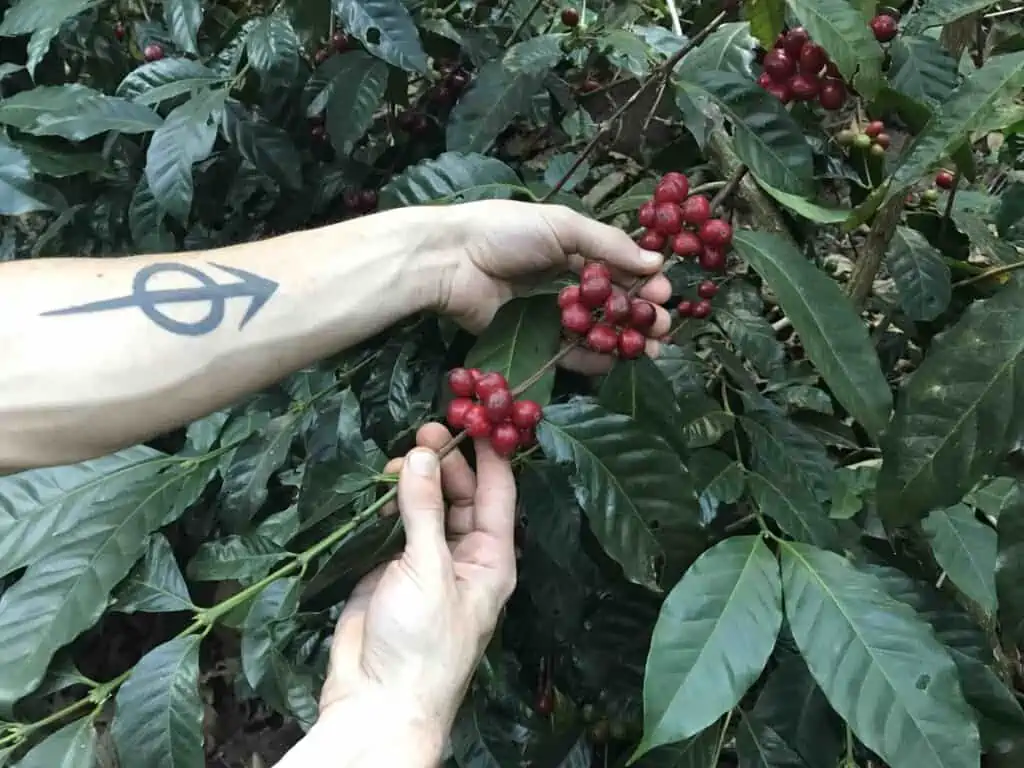
Checking for ripeness at Finca Nejapa in El Salvador. Courtesy of Chromatic Coffee.
The Compact Varieties
Largely over the latter half of the 20th century, nearly every country in Central America discovered its own version of a compact-growing, short-statured tree exhibiting what scientific circles might describe as phenotypic dwarfism: Pacas in El Salvador, Pache in Guatemala, Villalobos and Villa Sarchi in Costa Rica. The most popular, however, is Caturra, first selected in Brazil. Each of these compact varieties is a naturally occurring variant of Bourbon, selected and cultivated for their potential to be planted densely, increasing yield per hectare without compromising cup quality.
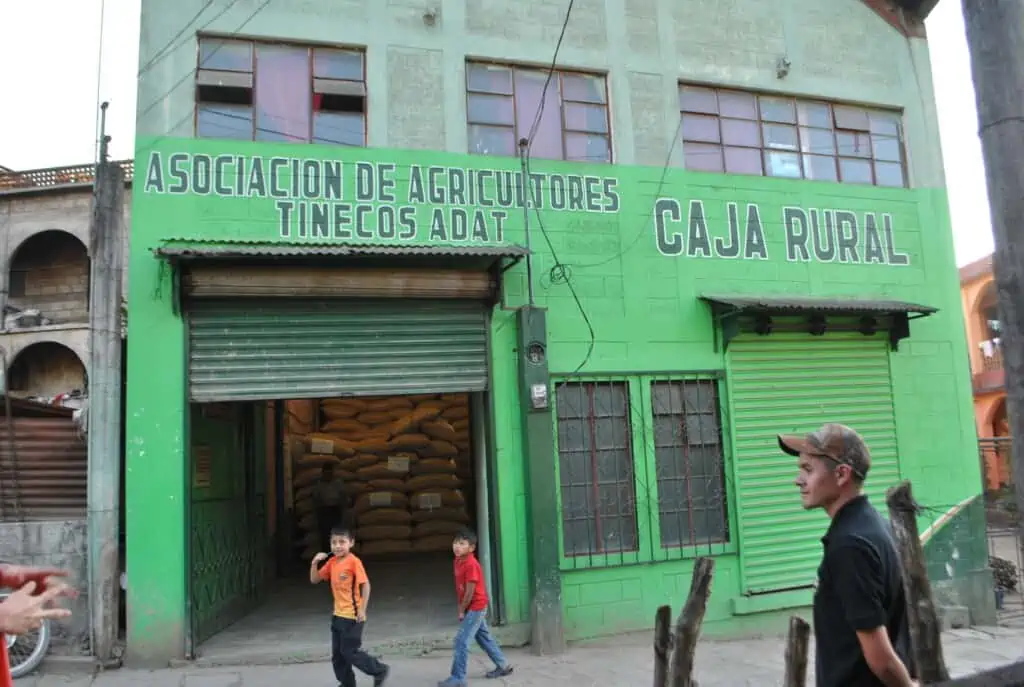
Green coffee in storage at La Asociación de Agricultores Tinecos – ADAT in Huehuetenango, Guatemala. Courtesy of Wonderstate Coffee.
Four of the top-rated coffees we review here were produced from field blends consisting mainly of such short-statured, compact varieties, sometimes mixing in beans from their parent variety, Bourbon. Among them, Wonderstate Coffee’s Guatemala Tojquia (93) is a particularly clear example of a Central America cup in the classic tradition, with a structure we found both unassuming and confident, supporting familiar suggestions of sweet citrus, cocoa, and tart flowers. Bird Rock’s Guatemala Don Angel (92), also produced from a field blend of Bourbon and compact Bourbon-derived varieties, is similarly vibrant yet comfortable, brightly and sweetly juicy in structure, with tart fruit, sweet nut and a hint of spicy flowers.
The Speckled Ax Guatemala Valentón (91), produced from another blend of short-statured varieties, is friendly and accessible, chocolaty and floral. Tico Coffee Roaster’s Costa Rica Finca San Luis (91) leans more toward sweet nut than chocolate, with a bright, invigorating acidity. The Tico sample was crafted by women-led teams on both the farming and the roasting side of the equation. The farm and mill are a family business in the storied Tarrazu region overseen by two sisters, Daniela and Tatiana Gutierrez, while the roast was done at Tico Coffee Roasters, a name that pays homage to owner Mariana Faerron’s own Costa Rican heritage (“Tico” is affectionate slang for a native of Costa Rica).
Only one top-rated sample, Flower Child’s beautiful roast of Roberto Figueroa’s Honduras green coffee (93), was produced exclusively from trees of a single short-statured variety, in this case, Pacas. It displays a thrilling version of its parent Bourbon’s tendency toward a fusion of savory depth and brightly sweet tendencies. Honduras is Central America’s coffee sector juggernaut, regularly ranking among the top five countries in Arabica production globally. The common perception is that Honduran cup quality suffers as a result of such bulk volume efforts, but Figueroa’s coffee is a sterling example of Honduras’s potential for quality.
Pacamara and the Classic Cup
Three of the coffees we review this month were produced from trees of Pacamara, a hybrid tree variety particularly associated with Central America. Pacamara’s long history in the region seemed to us to qualify it as a traditional variety. Pacamara is originally an El Salvador creation, released in the 1970s but worked on for more than 30 years prior at the genetic department of the Salvadoran Institute for Coffee Research (ISIC). Pacamara is now grown in many regions of Central America; this month, we review Pacamaras from El Salvador, Guatemala and Nicaragua. Pacamara is a cross of Pacas, the short-statured selection of Bourbon, and Maragogipe, a mammoth-beaned mutant of Typica. Pacamara retains the gigantic, showy beans of the Maragogipe while displaying a cup with a wide sensory range that often juxtaposes vibrant savory depth with light-footed floral notes. Pacamara is a challenging variety for producers since it is not stable from generation to generation and seedlings need to be edited for consistent appearance before planting. Nevertheless, it remains a favorite among some specialty producers in Central America and among many North American specialty roasters.
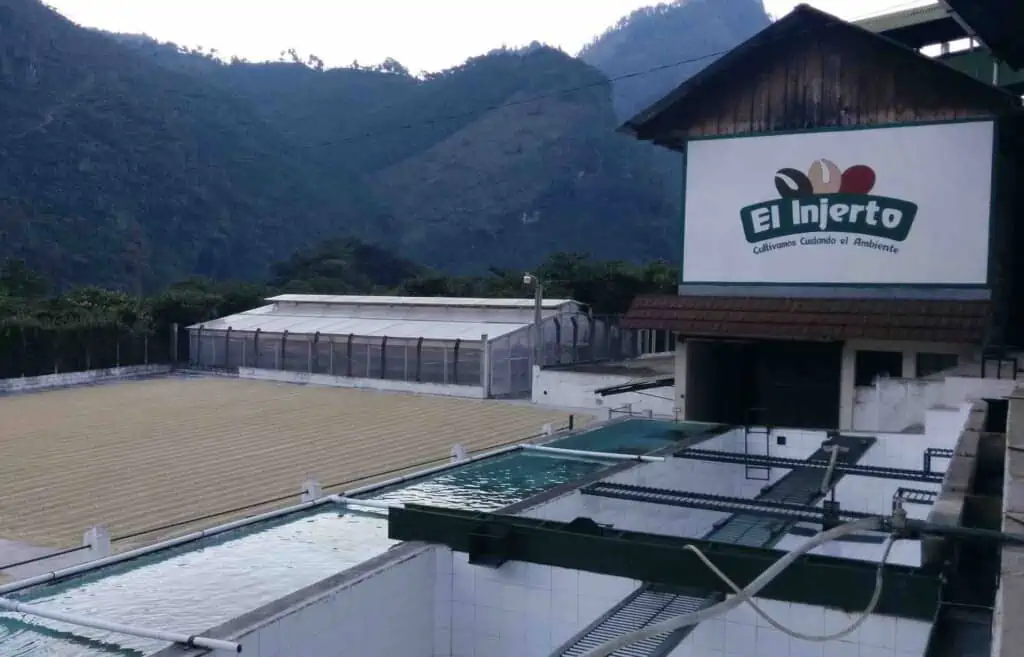
The wet-processing operation at El Injerto Farm in Guatemala. Courtesy of Equator Coffees.
The top-rated Equator Coffees Guatemala El Injerto Pacamara (94) was produced by the famous Guatemalan farm El Injerto, which has been producing top-caliber coffees for nearly its entire four-generation history. Finca El Injerto is a regular finalist in Guatemala’s annual Cup of Excellence green coffee competitions (with a staggering seven first-place finishes). Equator’s roast impressively displays the savory depth and intricately expressed sweet aromatics characteristic of this variety.
GK Coffee of Taiwan sent a Pacamara from El Salvador, the Finca Santa Elena El Corzo (92). Arguably more balanced and certainly quieter than the Equator El Injerto, it displays a crisp, chocolate-toned sweetness with orangy citrus and herb. Another Taiwan roaster, Sucré Beans, sent a Nicaragua Pacamara, the Jinotega Fincas Mierisch La Escondida (92), in which a characteristic Pacamara umami tendency contrasts with a delicate lemony citrus, both supported by a caramelly sweetness.
A Classic Future?
While there’s no current shortage of coffee in the world, nor of bulked beans grown in Central America, it can feel like a rarity to find coffees like those we tasted and rated for this report. The experience offers some hope of what may still be achieved if roasters, consumers, and producers can align on goals such as protecting the environment, fair wages for farm workers, and enjoyment of the simple pleasure of a coffee grown, harvested and processed in traditional ways with rigor and passion.

